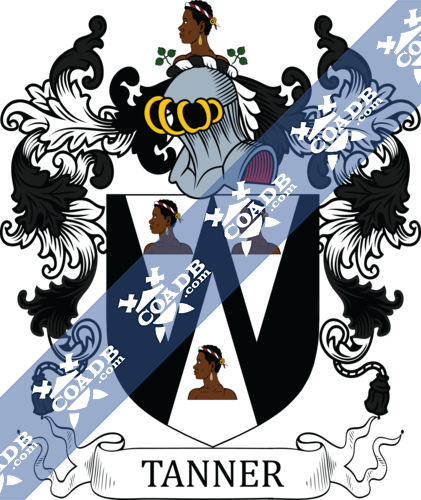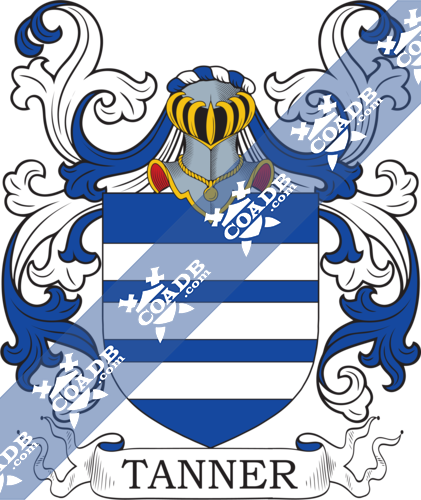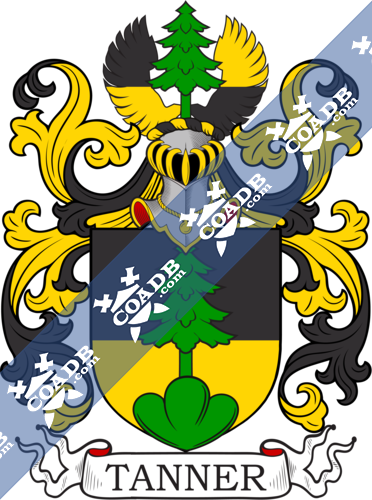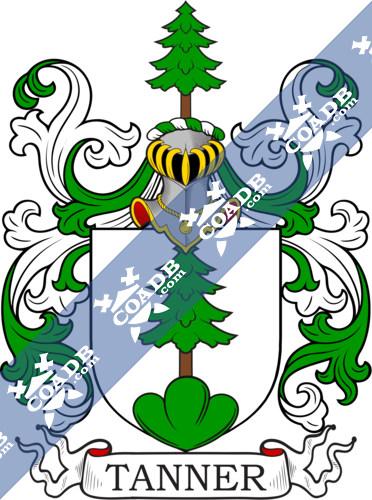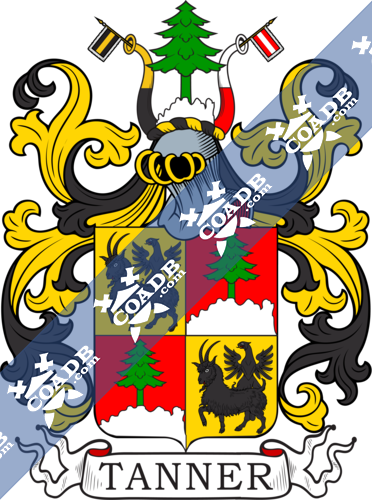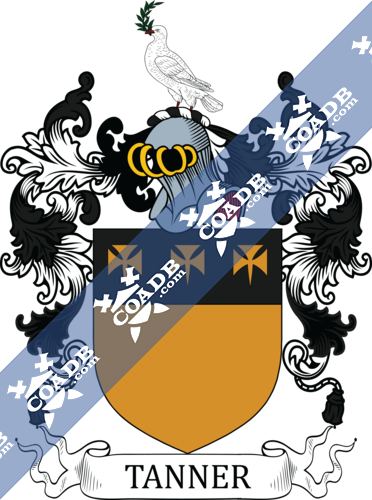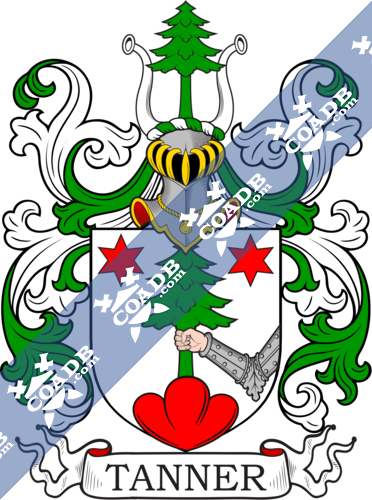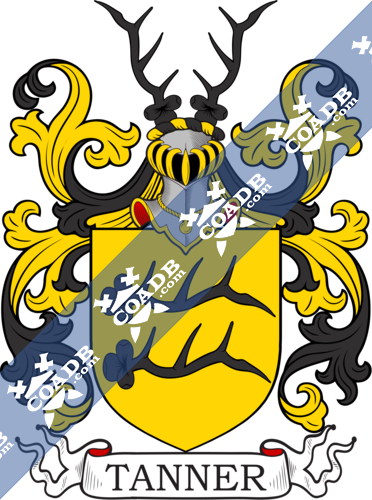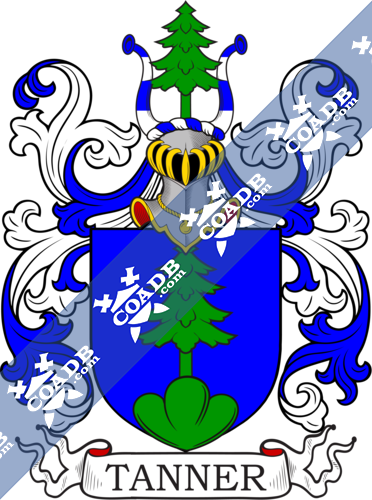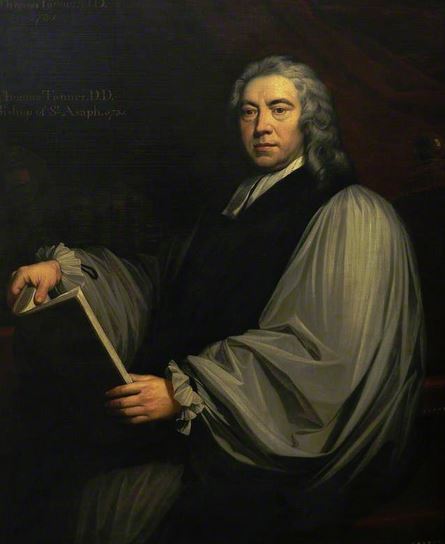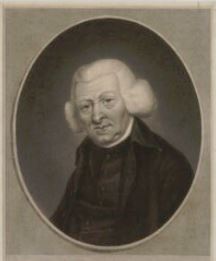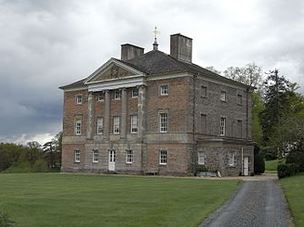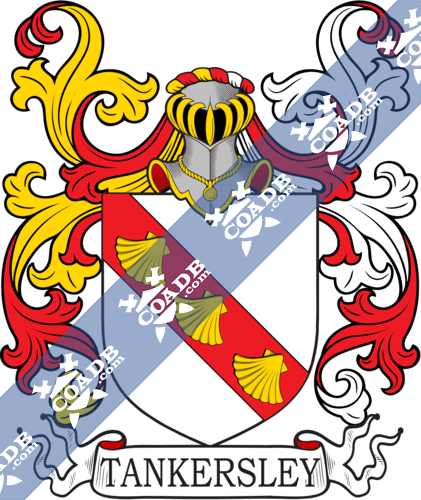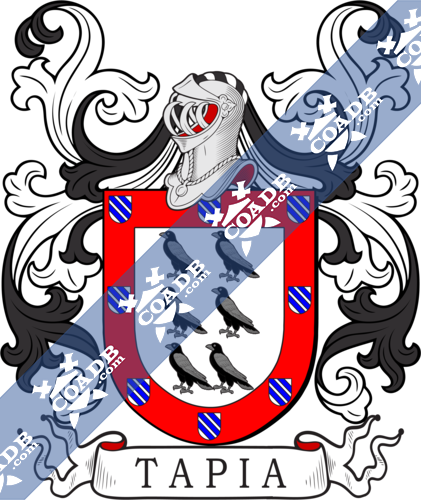Tanner Family Crest, Coat of Arms and Name History
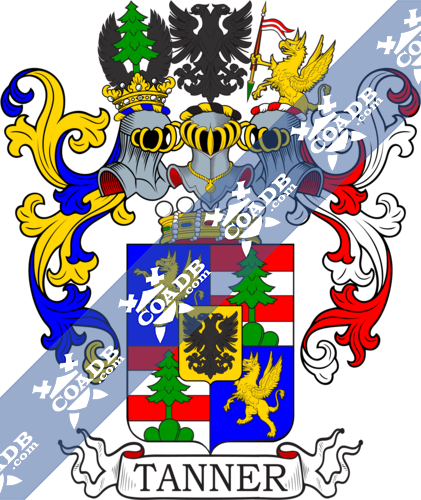
Tanner Coat of Arms Gallery
Don’t know which Coat of Arms is yours?
We can do a genealogical research. Find out the exact history of your family!
Learn MoreTanner Surname Name Meaning, Origin, History, & Etymology
This is an Anglo-Saxon and German/Austrian/Dutch occupational or metonymic surname meaning “the tanner”, a person who tanned leather, deriving from the Old English word tannere, which in turn derives from the Latin tannarius, which came to Britain via the Old French verb taneor during and after the Norman Conquest of 1066 AD. It may also derive from an ancient Celtic word for an oak tree, whose bark was used in the tanning process. Leather was a critical material during medieval times and the Middles ages as it was used in shoes, hardness, saddles, armor, and buckets. Tanning is the process in which animal skins and hides are turned into leather, a process which alter the protein structure, making it more durable and less susceptible to decomposition, involving the use of tannin, an acidic chemical compound, derived from oak tree bark in old times. It should also be noted the Old High German word for oak or fir trees is tanna (as in Tannenbaum). The verb for the process in Middle Dutch is taenre. One should also mention there are two other origins theories for the Tanner surname. First, in Germany and Switzerland, it could be a habitational name denoting a person who lived in several different locales called Tanne (one in the Harz Mountains and one in Silesia) or Tann (in southern Germany). Second, in Finland, it is an occupational name for a person who lived in or near an open field, deriving from the Finnish word tanner. Third, in Germany, it also may be a topographic name for a person who lived in or near a forest, deriving from the German word tan, meaning forest. One source asserts the family was first found in Devon, England where they held lands and titles for generations, and in Germany, the family was first found in Bavaria and Franconia.
Spelling Variations
Common spelling variants or names with similar etymologies include Tanour, Tannor, Taneur, Tannour, Taner, Tannur, Tanur, le Tannur, and Le Tanur. The German form of the name is Danner. A related surname is Barker, which refers to a similar/related occupation. Foreign similar names include Tanni (Norse), Tanno (Flemish), Tanne/Tannig (German), and Tanne (French).
Popularity & Geographic Distribution
The last name Tanner ranks 675th in popularity in the United Status as of the 2000 Census. The name ranks particularly high in the following six states: Utah, Georgia, Mississippi, West Virginia, Idaho, and South Carolina.
The surname Isaac frequency/commonness ranks as follows in the British Isles: England (699th), Scotland (1,281st), Wales (409th), Ireland (1,960th) and Northern Ireland (2,305th). In England, it ranks highest in county Wiltshire. In Scotland, the surname Tanner rankest highest in Ayrshire. In Wales, it ranks highest in county Merionethshire. In Ireland, it ranks highest in Longford. In Northern Ireland, it ranks highest in Londonderry.
The name is also present throughout the remainder English speaking world: Canada (1,025th), New Zealand (901st), Australia (711st), and South Africa (2,930th).
The 1890 book Homes of Family Names by H.B. Guppy, states the following in regard to this surname: “Tanner has been a name long known in Wilts; it was represented in Clarendon Forest two centuries ago”.
Early Bearers of the Surname
The earliest known bearer of this surname was Henry Taneur in the Pipe Rolls of Norfolk in 1166 AD. Lemmer le Tannur was documented in Yorkshire in 1175 AD. Ansketill le Tanur was documented in The Pipe Rolls of Cumberland, Westmorland, and Durham in 1189 AD. A one Thomas le Tannour rendered homage at Berwick in 1291 AD. The Hundred Rolls of 1273 AD, a census of Wales and England, known in Latin as Rotuli Hundredorum lists four bearers of this surname: Elfer Tannator (Sussex), John Tannarius (Oxfordshire), Philip le Tannour (Hungtingdonshire), and Henry le Tanur (Nottinghamshire). A one Henry le Tanner was documented in Somerset in 1327 AD in Kirby’s Quest. An early marriage involving this surname was Stephen Tanner to Alice Adams at St. Peter, Cornhill, London, in 1699 AD. An early baptism involving this name was Mary, daughter of James Tanner, at St. James Clerkenwell in 1613 AD.
Tanner Family Tree & Tanner Genealogy
Tanner of Kingsnympton Park
Reverend John Fowler Tanner of Kingsnympton Park, county Devon, England was a Justice of the Peace and Deputy Lieutenant who was born in 1831 and educated at Cambridge. In 1871, he married Eliza, daughter of M.W. Thompson, Esquire of Guiseley, county York, and had two issue with her: Charles Peile (1873) and Mary Agnes (1872). The lineage of this branch of the Tanner family tree traces back to James Tanner, Esquire of Kingsnympton Park, son of Robert Tanner and Mary Melluish, and grandson of Jonathan Tanner of Rose Ash, who in 1827, married Elizabeth, daughter of John Vowler of Parnacott, and had three issue with her: John Vowler (mentioned at the beginning of this paragraph), James Melluish (1833), and Mary (married Charles Malcom Kennedy of London in 1855). The Tanner Coat of Arms (sometimes mistakenly called the Tanner Family Crest) is blazoned in heraldry as follows: Argent, three Moor’s heads couped at the neck in enfiled(?) sable wreathed round the temples of the first and gules. Crest: A Moor’s head as in the arms. They resided at Eddgesford Parsonage, and were seated at Kingsnympton Park, near Chumleigh, North Devon, England.
Other
Elsbeth Tanner was born in Vorderen, Bern, Switzerland in 1545 AD. She married Hans Fankhauser and had four issue with him: David, Hans, Christen, and Heinrich.
Abraham Tanner was born in England in 1603 AD. He married Ann Floyd and had a son with her named Joseph. This Joseph Tanner was born in Henrico, Virginia in 1629 AD. He married Mary Browne Platt and had four children with her: Joseph II, Mary (Ligon), Edward Sr., and Martha (Jones). His son Joseph II was born in the same county in around 1661. He married Sarah Hatcher. He had the following children: Mary (Enroughty), Joseph, Thomas, Ludovich, and Lewis. His son Thomas Tanner was born in Virginia in 1685 who married a woman named Judith who and had two issue with her: Judith (Johns) and Joel. His son Joel was born in Virginia in 1732 and he had a son named Joseph. This Joseph Tanner was born in Florida in 1745.
Another source states Abraham Tanner, also known as Josias, was born in Einsiedeln, Switzerland around 1603, came to Virginia in colonial America, and he married Ann Floyd, from which the above lineage descends. He was the son of Johann Joseph Tanner who was born in the canton of Schwyz, Switzerland in around 1580, who in turn was the son of Johannes Tanner who was born in the same canton in 1546.
William Tanner was born in Rhode Island in 1608. He married Mary Babcock. He had a son named Francis. This son was General Francis Turner (or Francis I) was born in England in 1634. He married Elizabeth Colgrove and had a son with her. This son was William Tanner who was born in England around 1660. He married several times and had numerous issue as follows: William II, Thomas, John T., Avis (Barber), Jane (West), Benjamin, Thomas, Mary (Willet), Francis, Nathan, Anna, Rebecca, Elizabeth, and Abigail.
Early American and New World Settlers
A one Daniell Tanner was documented as living in Virginia in February of 1623 at “Elizabeth Cittie”. He came aboard the Sampson at the age of 40 in 1618. Josias Tanner, age 24, came to Virginia aboard the John & Francis in 1624. Elizabeth, daughter of Mary Tanner, was baptized in December of 1678 in the parish of St. Michael’s in the Barbados. Other early settlers in colonial America bearing this surname include Barbary Tanner (Virginia 1635), Daniel Tanner (Virginia 1640), Tobias Tanner (Virginia 1642), Anne Tanner (Virginia 1703), Urban Tanner (New England 1709), Palle Tanner (Virginia 1714), Thomas Tanner (Virginia 1715), and Michael Tanner (Pennsylvania 1727).
In Canada, one of the first bearers of this last name was Samuel Tanner, who came to Nova Scotia around 1750. In Australia, of one the earliest bearers was John Tanner, a convict from Southampton, England who arrived in New South Wales (then a penal colony) aboard the Ann in 1809. In New Zealand, Herbert E. Tanner, a carpenter age 19 years, came aboard the Duke of Edinburgh in 1873 and arrived in the city of Wellington.
Early Americans Bearing the Tanner Family Crest
I researched the following three resources and did not find any coats of arms for Tanner: Bolton’s American Armory, Matthew’s American Armoury and Bluebook, and Crozier’s General Armory.
Mottoes
I have been unable to identify the Tanner family motto.
Grantees
We have 14 coats of arms for the Tanner surname depicted here. These 14 blazons are from Bernard Burke’s book The General Armory of England, Ireland, and Scotland, which was published in 1848. The bottom of this page contains the blazons, and in many instances contains some historical, geographical, and genealogical about where coat of arms was found and who bore it. People with this last name that bore an Tanner Coat of Arms (or mistakenly called the Family Crest)
1) Tanner, of Exeter in county Devon, see Williams, Match (1813).
Notables
There are hundreds of notable people with the Tanner surname. This page will mention a handful. Famous people with this last name include: 1) Antwon Tanner (1975) who is an American actor born in Chicago, Illinois best known for his role in the TV sitcoms Moesha and The Parkers, 2) Charles R. Tanner (1896-1974) who was an American author of fantasy and science fiction whose first short story was “The Color of Space”, 3) Henry Ossawa Tanner (1859-1937) who was an American artist born in Pittsburgh, PA who was the first African-American to gain international acclaim, known for his paining entitled Daniel in the Lion’s Den, 4) John Sigismund Tanner (1705-1775) who was an engraver of coins and medals for the Kingdom of Great Britain who was born in Saxe-Coburg, 5) William Cunningham Deane-Tanner (1872-1922), was an American actor and director born in Carlow, Ireland, who went by the stage name William Demond, who was a popular figure in early Hollywood who directed nearly 100 silent films and was murdered, leading to sensationalist journalism and speculation, although the case still remains cold, 6) Robin Tanner (1905-19878) who was an English artist and etcher from Bristol who followed the English neo-romanticism school, 7) James Gideon Tanner (1885-1960) who was an old time American fiddler born in Georgia who was one of the earliest stars in the music genre that would become known as country, whose band was named the Skillet Lickers, 8) James Tolman Tanner (1858-1915) who was an English stage director and dramatist who wrote several musicals produced by George Edwardes, and 9) Paul Tanner (1917-2013) who was an American musician born in Skunk Hollow, Kentucky who was a member of the famous/legendary Glenn Miller Orchestra.
Blazons & Genealogy Notes
1) (Brannell, co. Cornwall; John Tanner, of Brannell, Visit. Cornwall, 1620, son of Anthony Tanner, of same place, grandson of George Tanner, of Collumpton, co. Devon, and great-grandson of John Tanner, of same place). (Kingsnympton Park, co. Devon). (Salisbury, co. Wilts, Sherborne and Wimborne, co. Dorset). Ar. on a chief sa. three Moors’ heads in profile couped at the neck sa. banded about the temples of the first and gu. Crest—A demi talbot ramp. or, eared ar.
2) (Ashted, co. Surrey). Sa. on a chief or, three Moors’ heads couped ppr. Crest—A demi antelope ramp, reguard. erm.
3) (assigned by Molyneux, Ulster, 1613, to Right Rev. John Tanner, Bishop of Derry). (co. Limerick; Fun. Ent. Ulster’s Office, 1658). Or, on a chief sa. three crosses formée fitchée of the first. Crest—A dove ar. beaked and legged gu. holding in the beak an olive branch vert.
4) (William Tanner Farncombe-Tanner, formerly William Tanner Farncombe, of East Lenham, co. Kent, Esq.). Sa. three piles ar. two issuant from the chief, and one from the base, each charged with a Moor’s head in profile, couped at the shoulder ppr. wreathed about the temples of the second and gu. Crest—A Moor’s head, as in the arms, betw. two trefoils slipped vert.
5) Azure three bars argent.
6) Berne – D’argent à un senestrochère armé d’argent mouvant du flanc la main de carnation empoignant le fût d’un sapin de sinople posé sur un tertre de gueules et accosté en chef de deux étoiles du même Cimier un sapin de sinople entre deux proboscides d’argent. English: Argent with a left arm armoured argent coming from the flank the hand carnation holding in its fist the trunk of a fir tree vert placed on a hillock gules and side by side in chief two etoiles of the same Crest: a fir tree vert between two proboscides argent.
7) Bavière – (Barons du St-Empire, 18 avril 1668) – Écartelé aux 1 et 4 d’argent chaussé-ployé d’azur l’argent chargé d’un sapin de sinople et l’azur de deux bras armés d’argent tenant chacun un sabre du même et mouvant des flancs aux 2 et 3 de gueules à la fasce d’argent acc de trois croissants versés du même Deux casques couronnés Cimiers 1° trois plumes d’autruche une d’argent entre deux d’azur Lambrequin d’argent et d’azur 2° un demi-vol aux armes du 2 Lambrequin d’argent et de gueules. English: Quarterly 1st and 4th argent chausse ploye [division curved from middle base to dex & sin top] azure the argent charged with a fir tree vert and the azure with two arms armoured argent holding each a sabre of the same and coming of flanks 2nd and 3rd gules a fess argent accompanied by three crescents inverted of the same Crowned with two helmets Crests: 1st three ostrich feathers a argent between two azure Mantling: argent and azure 2nd a single wing with the arms of the 2nd quarter Mantling: argent and gules.
8) Schwäbisch-Hall (Wurtemberg) – D’or à deux demi-ramures de cerf de sable posées en fasces l’une sur l’autre Cimier une ramure de cerf de sable. English: Or two antlers of a stag sable placed fesswise in pale Crest: a pair of antlers of stag sable.
9) Saint-Gall – D’azur à un sapin de sinople terrassé du même Cimier le sapin entre deux proboscides fascées d’azur et d’argent de quatre pièces Lambrequin d’argent et d’azur. English: Azure with a fir tree vert on a mount of the same Crest: the fir tree between two proboscides barry azure and argent of four pieces Mantling: argent and azure.
10) Autriche – Coupé de sable sur or à un sapin de sinople brochant sur le tout et posé sur un tertre du même Casque couronné Cimier le sapin entre un vol coupé alternativement de sable et d’or Lambrequin d’or et de sable. English: Per fess sable over or with a fir tree vert covering overall and placed on a hillock of the same Crowned with a helmet Crest: the fir tree between a pair of wings per fess alternately sable and or Mantling: or and sable.
11) Allemagne – D’argent à un sapin terrassé au naturel Cimier le sapin Lambrequin d’argent et de sinople. English: Argent with a fir tree on a mount proper Crest: the fir tree Mantling: argent and vert.
12) (Barons) – Autriche – Écartelé aux 1 et 4 d’azur à un griffon d’or aux 2 et 3 fascé de gueules et d’argent de quatre pièces à un sapin de sinople brochant sur le fascé et terrassé de sinople Sur le tout d’or à l’aigle éployée de sable Trois casques le 1 couronné Cimiers 1° un sapin de sinople entre un vol de sable 2° l’aigle 3° un griffon issant d’or tenant un pennon fascé d’argent et de gueules de quatre pièces attaché à une lance de tournoi de gueules Lambrequin à dextre d’or et d’azur à senestre d’argent et de gueules. English: Quarterly 1st and 4th azure with a griffin or 2nd and 3rd barry gules and argent of four pieces with a fir tree vert covering over the barry and on a mount vert overall or with an eagle displayed sable three helmets the first crowned Crests: 1st a fir tree vert between a pair of wings sable 2nd an eagle 3rd a griffin issuant or holding a small triangular flag barry argent and gules of four pieces attached to a tournament lance gules Mantling: to the dexter or and azure to the sinister argent and gules.
13) Allemagne – Parti au 1 d’argent à un griffon de gueules au 2 de gueules à un sapin de sinople posé sur un tertre du même Casque couronné Cimier le griffon issant tenant de ses pattes un sapin de sinople Lambrequin d’argent et de gueules. English: Per pale 1st argent with a griffin gules 2nd gules with a fir tree vert placed on a hillock of the same Crowned with a helmet Crest: the griffin issuant holding in its paws a fir tree vert Mantling: argent and gules.
14) Allemagne – Écartelé aux 1 et 4 d’or à un bouc passant au naturel supp une aigle au naturel aux 2 et 3 de gueules à un sapin de sinople posé sur une terrasse rocheuse d’argent Casque couronné Cimier les meubles du 2 entre deux proboscides coupées à dextre d’or sur sable à senestre d’argent sur gueules ornées chacune dans son embouchure d’une bannière celle à dextre de sable ch d’une fasce d’or celle à senestre de gueules ch d’une fasce d’argent Lambrequin d’or et de sable. English: Quarterly 1st and 4th or with a goat passant proper supporting an eagle proper 2nd and 3rd gules with a fir tree vert placed on a rocky mount argent Crowned with a helmet Crest: the charges of the 2nd between two proboscides per fess to the dexter or over sable to the sinister argent over gules decorated each in its mouthpiece a square flag that to the dexter sable charged with a fess or that to the sinister gules charged with a fess argent Mantling: or and sable.

